Did you know that some birds kept as pets are known to outlive their owners? Here’s another interesting fact – upon researching these birds’ lifespans, we discovered they lived much longer in captivity, sometimes doubling the maximum lifespan of their wild relatives. How crazy is that?!
Without further ado, let’s discover some of the world’s longest-living birds!
Table of Contents
12 Birds with the Longest Lifespan
Before discussing every bird in detail, we must mention that not all the numbers mentioned below have been scientifically confirmed. Moreover, some birds are known to have broken records with their lifespans but this isn’t an indicator that all other individuals of the same species can reach the same old age.
Besides this, the lifespan of many birds remains unknown, so we cannot be 100% sure that this or that bird is the longest-living species. Naturally, these are only estimations until ornithologists provide a scientifically confirmed list upon studying every single bird species this world hosts!
1. Sulphur-crested Cockatoo
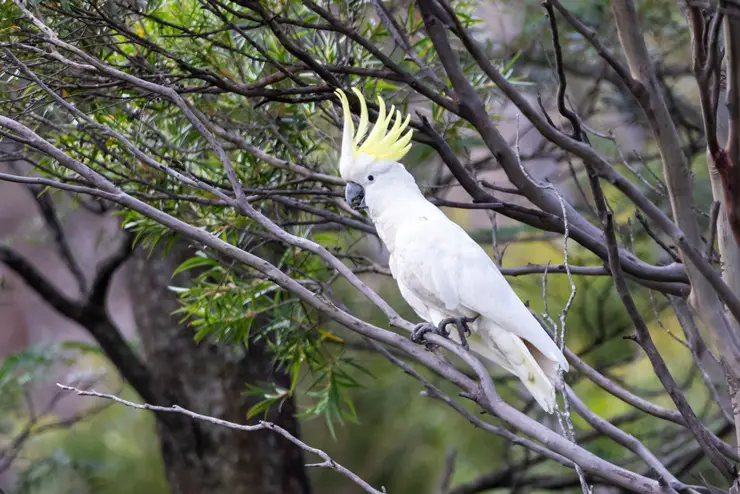
- Scientific name: Cacatua galerita
- Size: 44-55 cm (17.5-21.5 inches)
- Weight: 780 g (27.5 oz)
- Wingspan: 103 cm (40.6 in)
Sulphur-crested cockatoos typically live 20-40 years in the wild. However, they can survive much longer in captivity, reaching more than 70 years. In fact, one sulphur-crested cockatoo called Cocky Bennett is believed to have died at 120 years old. It lived between 1796 and 1916. How amazing is this?!
These parrots are part of the Cacatuidae family. They are predominantly white, which contrasts with the yellow underwing and under-tail feathers. Their crests are yellow as well, while the bills are black.
They naturally occur in Australia, New Guinea, and Indonesia but have been introduced to Singapore, Palau, and Hawaii. They are intelligent creatures that can adapt to various habitats, although generally avoid arid areas with few to no trees.
The beginning of the breeding season depends on their geographic location. In northern Australia, for example, the breeding season occurs from May to September, while in the southern part, it starts in August and lasts until January. During this time, sulphur-crested cockatoos build nests in tree hollows.
Sulphur-crested cockatoos typically forage on the ground, looking for plants, nuts, insects, and grass seeds.
2. Major Mitchell’s Cockatoo

- Scientific name: Lophochroa leadbeateri
- Size: 33-40 cm (13-15.7 in)
- Weight: 480 g (16.9 oz)
- Wingspan: 81 cm (31.9 in)
Major Mitchell’s cockatoos are known to be among the world’s longest-living birds. One individual living in Brookfield Zoo in the United States died at the age of 83. This male bird was called Cookie. It hatched in 1933 and died in 2016.
This cockatoo species is often called the pink cockatoo or Leadbeater’s cockatoo. It’s a medium-sized bird with beautiful white and pale salmon-like pink plumage and a bright red and yellow crest.
These pink birds live in Australia’s arid and semi-arid inland areas with extensive woodlands. The mating season occurs between August and October when both parents build nests that may be used for several years.
Since they’re not very good fliers, Major Mitchell’s cockatoos spend much of their foraging time on the ground. While they’re generally considered herbivorous, these pink birds occasionally enjoy an insect meal. Otherwise, they primarily eat fruits, nuts, and seeds.
3. Green-Winged Macaw
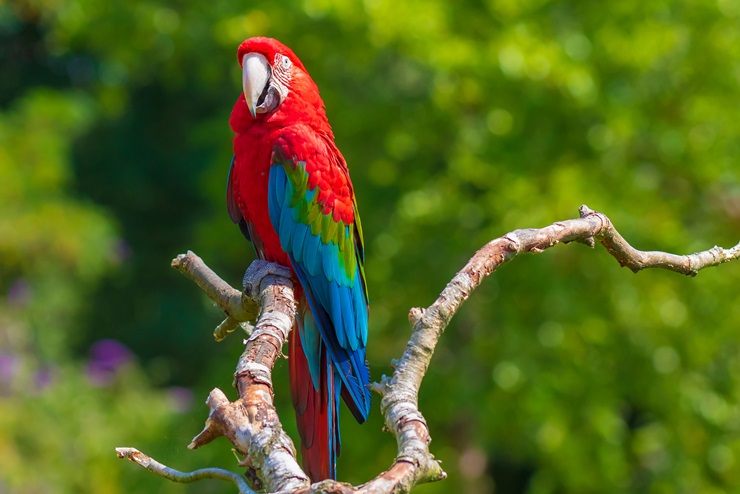
- Scientific name: Ara chloropterus
- Size: 90-95 cm (35-37 in)
- Weight: 1.2 kg (2.7 lb)
- Wingspan: 1.3 m (50 in)
Green-winged macaws go straight after the second birds on our list, with a lifespan of 60-80 years. Naturally, such long-living birds are probably reported from captivity rather than the wild.
On the other hand, these reports haven’t been officially confirmed and verified. But who knows, maybe one of these birds will break the world record soon, right?!
The green-winged macaw is often called the red-and-green macaw due to its distinctive plumage coloration. The bird is predominantly red, but its wings have bright green and blue feathers. It must be quite a sight if spotted in flight!
We wouldn’t mind observing them at least once foraging for berries, fruits, seeds, and nuts. Such a sight is most definitely a delight for bird enthusiasts!
These macaws are native to South America. They live in the northern and central parts of the continent, residing in forests and woodlands. Naturally, they do not migrate.
Did you know that green-winged macaws mate for life once they form a pair?! After mating, they build nests in tree holes, where females lay 2-3 eggs.
4. Laysan Albatross

- Scientific name: Phoebastria immutabilis
- Size: 81 cm (32 in)
- Weight: 1.9-4.1 kg (4.2-9 lb)
- Wingspan: 195-204 cm (77-80 in)
Wisdom is a female Laysan albatross known to be the world’s oldest known wild bird! It is estimated that this bird hatched in 1951, although this date isn’t set in stone, as it would be impossible to confirm it’s 100% accurate.
In 1956, Wisdom was tagged and kept track of, so the bird is undoubtedly still alive. In 2016, scientists estimated that the bird was approximately 66 years old, meaning that now it’s over 70 years old.
The tag showed that Wisdom traveled in flight over 4,800,000 km (3,000,000 miles). Just imagine this! It’s more than 100 times the circumference of our planet!
Laysan albatrosses are typically distributed throughout the North Pacific, being one of the most common seabirds of the Hawaiian Islands. Outside the breeding season, Laysan albatrosses are found from Japan to the Bering Sea.
These large birds have a black-white-gray plumage combination. The bill is pink and has a dark tip. In fact, they look very similar to gulls, so if you’ve ever spotted one, you’ll likely identify a Laysan albatross just as easily!
As colonial breeders, these seabirds build various types of nests on small islands. They typically feed on cephalopods, fish, and crustaceans.
5. Blue-and-yellow Macaw
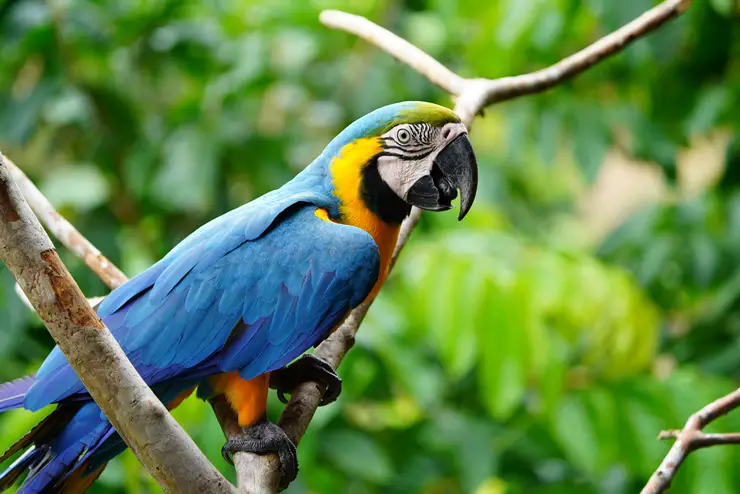
- Scientific name: Ara ararauna
- Size: 76-86 cm (30-34 in)
- Weight: 0.9-1.5 kg (2-3 lb)
- Wingspan: 102-112.5 cm (40.2-44.3 in)
Yet another parrot on our list – long-living they are, aren’t they?! In the wild, blue-and-yellow macaws live roughly 35 years. On the other hand, captive birds are known to reach a lifespan of up to 60 years if kept in good health and provided with a nutritious diet.
The blue-and-yellow macaw gets its name (yes, you guessed it!) from its vivid plumage color – bright aqua on top, lime-colored head, and rich yellow-orange underparts. The beak is black, and the irises are pale yellow.
South America is home to these brightly colored parrots. More precisely, they can be found in Colombia, Brazil, Venezuela, Peru, Bolivia, Paraguay, and Ecuador. During the breeding season, blue-and-yellow macaws stay in rural and forested areas, building nests in Mauritia flexuosa palms. Like many other parrots, they mate for life.
While foraging, blue-and-yellow macaws rely on their powerful beaks to climb up on trees and break nutshells. As such, they feed primarily on nuts but may also eat seeds, bark, leaves, and fruits. Occasionally, they may hunt insects and snails. These bright creatures have even been observed hunting small animals!
6. California Condor

- Scientific name: Gymnogyps californianus
- Size: 109-140 cm (43-55 in)
- Weight: 7-14.1 kg (15-31 lb)
- Wingspan: 2.49-3 m (8.2-9.8 ft)
California Condors are probably among the largest species on our list! Like other birds on our list, they are known to live up to 60 years old, even in the wild, because they don’t have many natural predators.
These large raptors are predominantly black but feature triangular white patches or bands on the wing undersides. Their bills are ivory-colored, their eyes are brownish-red, and their heads are almost featherless.
Since California condors Critically Endangered, they are now found only in California, Baja California, Mexico, Arizona, and Utah. They inhabit rocky shrublands and coniferous forests. Some populations are found in oak savannas. During the breeding season, they build nests near cliffs or on large trees.
These birds are known to travel more than 250 km (160 mi) daily to look for carrion, which is their primary source of food. They prefer scavenging mammalian caracasses – deer, donkeys, sheep, cougar, bears, and cattle. California condors can go without food for up to two weeks. Then, they take meals of up to 1-1.5 kg (2.2-3.3 lb) and rest for another two weeks!
7. Egyptian Vulture
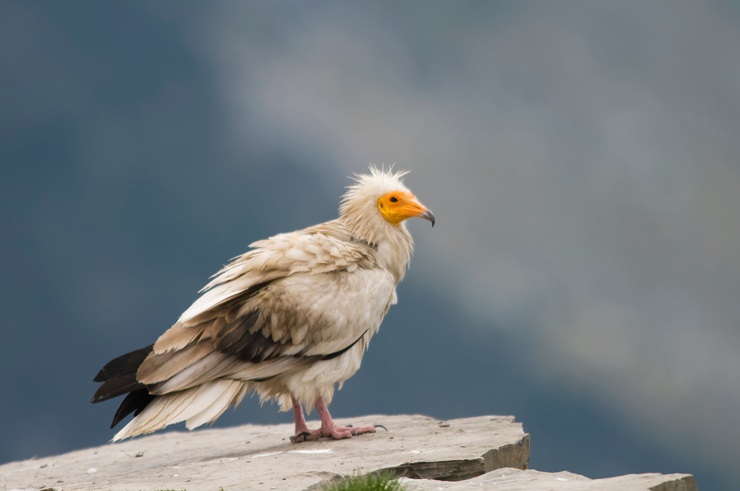
- Scientific name: Neophron percnopterus
- Size: 47-65 cm (19-26 in)
- Weight: 1.9-2.4 kg (4.2-5.3 lb)
- Wingspan: 1.5-1.7 m (4.9-5.6 ft)
Egyptian vultures are known to have quite a long lifespan. In captivity, these creatures can live up to 37 years, while they survive only 21 years in the wild.
However, one particular Egyptian vulture living in Jurong Bird Park is known to have died at approximately 60 years old. The word goes that this bird had been part of the park since 1971.
The Egyptian vulture doesn’t have a typical vulture appearance. Instead, it’s predominantly white, while its wing flight feathers are black. Moreover, the birds living in the wild have a rusty or brown shade.
These remarkable vultures are spread across the Old World (Afro-Eurasia). During the breeding season, they’re found from southern Europe and northern Africa to southern and western Asia. Not all populations are migratory.
Egyptian vultures prefer living in low-hill habitats, although the populations living in the Himalayas may remain at higher altitudes. While foraging, these large birds look for various types of food, starting from mammal feces and carrion and ending with small animals.
During the breeding season, Egyptian vultures build untidy platforms as nests. These nests are typically used for several years.
8. White Cockatoo
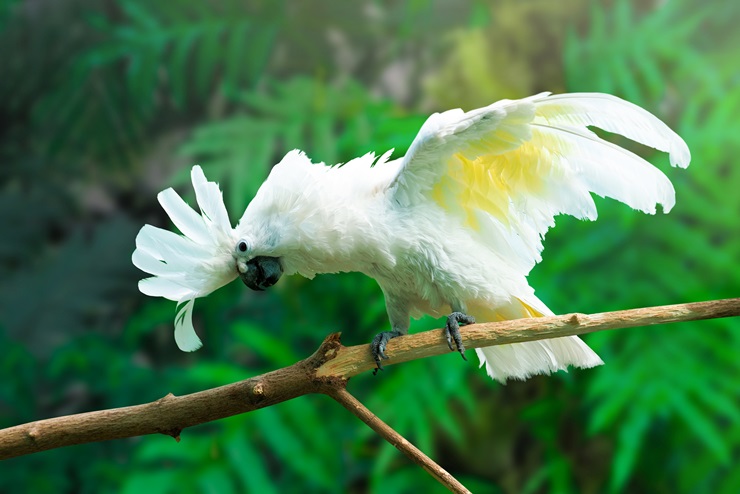
- Scientific name: Cacatua alba
- Size: 46 cm (18 in)
- Weight: 400-800 g (14-28 oz)
- Wingspan: 23-31 cm (9-12 in)
Yet another cockatoo on our list! However, as you’ve probably noticed, it’s farther down on our list, meaning it’s not as long-living as the other two cockatoos we started our article with.
Although no official data confirms the lifespan of these stunning birds, it is estimated that white cockatoos live up to 40-60 years in captivity. On the other hand, wild birds are more prone to premature death, as many scientists think they do not get to live more than approximately 30 years.
As their name suggests, white cockatoos are predominantly white, although they have some yellow colors.
White cockatoos are distributed across several Indonesian islands. They live in lowland tropical forests, mangroves, and agricultural lands, where they’re year-round residents.
During the breeding season, white cockatoos build their nests in tree hollows. Before this, they forage extensively in preparation for breeding and nesting. They look for berries, seeds, fruits, nuts, roots, insects, and insect larvae.
9. Bald Eagle
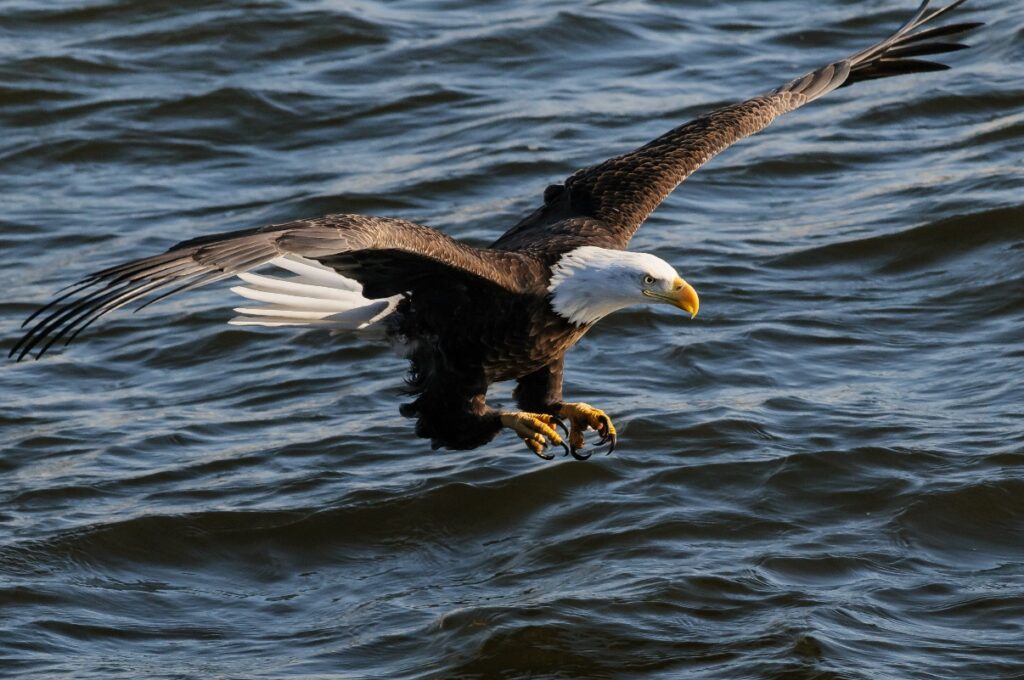
- Scientific name: Haliaeetus leucocephalus
- Size: 70-102 cm (28-40 in)
- Weight: 3-6.3 kg (6.6-13.9 lb)
- Wingspan: 1.8-2.3 m (5.9-9.8 ft)
The bald eagle is probably among the world’s most renowned birds of prey. Wild individuals are believed to have a lifespan of only 20 years.
In captivity, however, Bald Eagles’ lifespan doubles, reaching 38 years on average. In fact, a captive bald eagle living in New York died at the age of 50 years!
A bald eagle’s distinctive plumage colors make it easy to recognize! They are mostly dark brown but have white heads and tails. Their beaks are bright yellow, as are the feet and the irises.
These raptors are quite common across North America. Most populations are migratory, but their migration routes depend on their geographic location.
During the breeding season, which typically begins in mid-February, bald eagles are found in wetlands, where they primarily look for coniferous and hardwood trees to build their nests on. However, they’re quite adaptable, so they can nest in other types of trees and vegetation, depending on their location.
These opportunistic carnivores are known to have fed on more than 400 species of fish, birds, mammals, and others!
10. American Flamingo
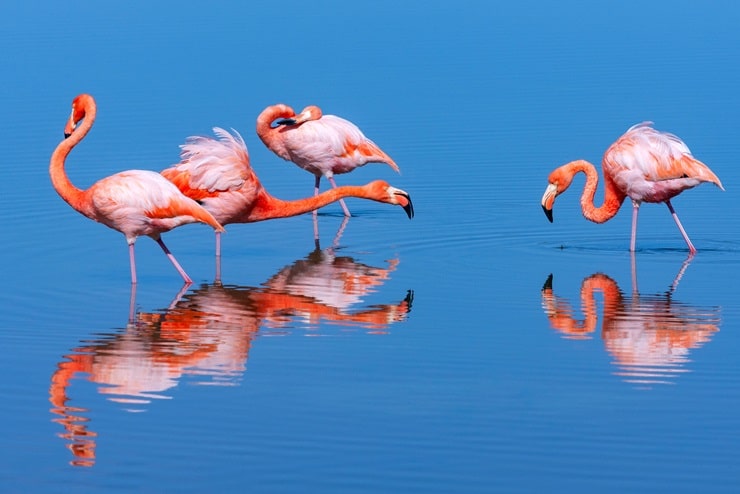
- Scientific name: Phoenicopterus ruber
- Size: 120-145 cm (47-57 in)
- Weight: 2.2-2.8 kg (4.9-6.2 lb)
- Wingspan: 1.5 m (4.9 ft)
The American flamingo is widely renowned for its bright pink plumage and the fact that it stands on one leg! Besides this, it has a distinctive pinkish-white bill with a contrasting black tip. The legs are pink as well!
Besides their unique reddish-pink plumage, American flamingoes stand out among other birds due to their long lifespan. They’re known to live approximately 40 years.
American flamingos are found only in the Americas. They live in South America and North America’s tropical and subtropical regions during the breeding season. They occur in mudflats, shallow-brackish coastal waters, saline lagoons, and inland lakes. These pink birds migrate only short distances.
Their diet depends on their geographic location. However, it’s known that American flamingos typically eat crustaceans, mollusks, worms, insects, small fish, seeds, and algae. While feeding, these birds may keep their heads underwater for long periods.
11. Great Frigatebird
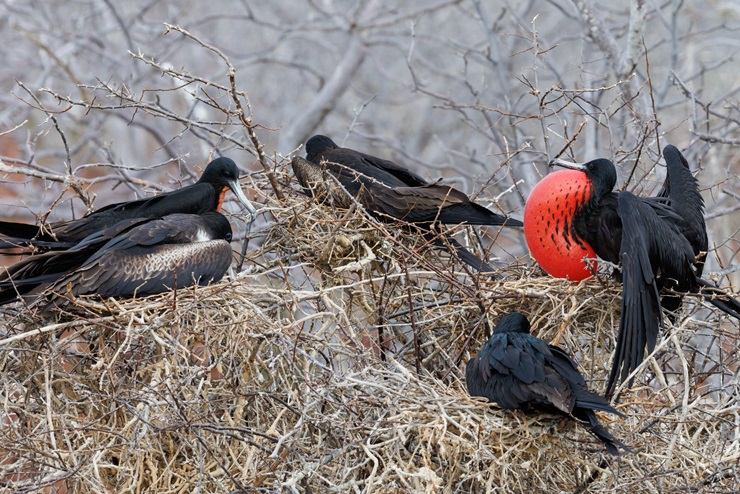
- Scientific name: Fregata minor
- Size: 85-105 cm (33-41 in)
- Weight: 1,000-1,590 g (2.2-3,5 lb)
- Wingspan: 205-230 cm (81-91 in)
Although the maximum lifespan great frigatebirds can acquire hasn’t been officially confirmed yet, a study showed that some recaptured great frigate birds were between 37 and 44 years old.
The great frigatebird doesn’t only have a long lifespan, it’s also of remarkable appearance! While they’re primarily black with some green iridescence, they also have a distinctive patch of skin at the throat called a gular sac. This is observable in males during the breeding season when they inflate the bright red gular sac to attract females!
Great frigatebirds are widely distributed across tropical seas and occasionally engage in migratory behavior. During the breeding season, these birds reside in colonies and build nests in trees or bushes. They feed in pelagic waters, where they look for flying fish and squid but may occasionally eat seabird chicks.
12. Sooty Tern
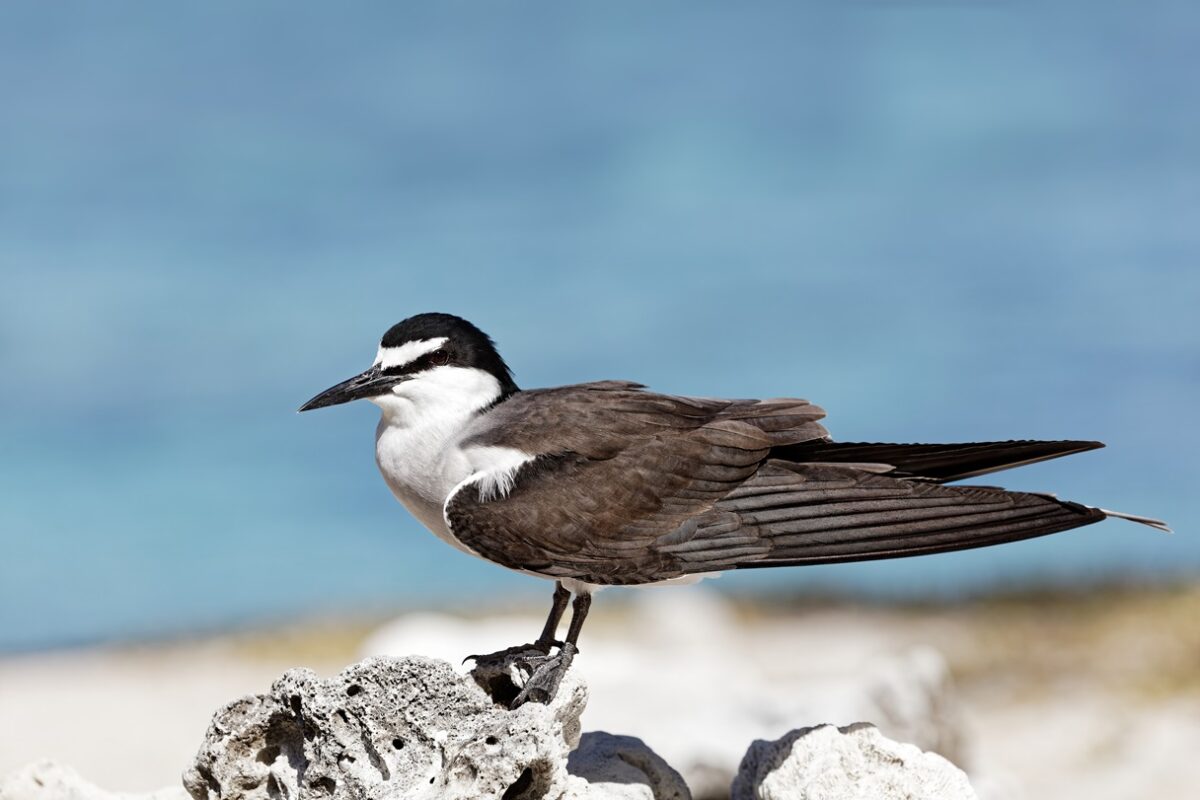
- Scientific name: Onychoprion fuscatus
- Size: 33-36 cm (13-14 in)
- Weight: 180 g (6.3 oz)
- Wingspan: 82-94 cm (32.5-37 in)
Last but not least – the sooty tern, a gorgeous seabird! Although not as long-living as other birds on our list, the sooty tern has an average lifespan of 32 years. Nobody knows what the maximum lifespan is, so it can, in fact, live much longer!
Considering that it spends much of its time above the water and has to withstand harsh weather conditions, such a lifespan is truly impressive!
These creatures are black on the upperparts and white on the underparts. Their legs and bills are black.
Sooty terns are found across the world’s tropical oceans. Only rarely, typically after severe storms, are these birds spotted inland.
During the breeding season, they are found on islands in the equatorial zone. They breed in colonies (which sometimes consist of a million pairs!) and build nests on the ground.
Like other seabirds, sooty terns feed on goatfish, flying fish, squid, and mackerel scad.
